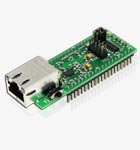 |
neCore12 is a low-cost family of DIP modules that brings the advanced features of the Freescale MC9S12NE series of "networked embeddable" microcontrollers within easy reach of engineers, students, and hobbyists. The flexible design accommodates all facets of training, evaluation, development, prototyping-- and even volume production.
Ethernet isn't just for offices anymore. Freescale Semiconductor's MC9S12NE64 single-chip, Flash-based Ethernet solution with an embedded 10/100 Ethernet media access controller (EMAC) and Ethernet physical layer (EPHY) meets the needs of design engineers working on applications such as networked applicances, security systems, industrial controls and Web radio.
The MC9S12NE64 is a 16-bit microcontroller that can be matched with a third-party TCP/IP stack of your choice to achieve a low-cost end-node Ethernet solution. The MC9S12NE64 is based on the powerful HCS12 core, which integrates third-generation Flash technology. Its rich offering of Ethernet connectivity features makes the MC9S12NE64 a favorite to replace noisy multichip solutions with full-featured Ethernet connectivity.
- 25 MHz 16-bit HCS12 CPU core
- On-chip debug interface
- Integrated third-generation Flash memory
- 10/100 Mbps EMAC
- 10/100 Mbps EPHY
- 10-bit ADC
- Clock and reset module
- Timer
- Two serial communications interfaces
- Serial peripheral interface
Product Info
- based on the 9S12NE64 MCU (80-pin QFP version)
- 10/100 Mbps Ethernet with Integrated Modular RJ45 jack
- includes 25 Mhz crystal
- implements PLL loop filter circuit, supporting up to 50MHz operation (25 MHz bus speed)
- local 3.3 Volt low-dropout 500 mA regulator
- includes RS232 transceiver circuit
- has on-chip Serial Monitor for easy code-loading and simple debugging
- supports standalone operation
- 64K Bytes Flash
- 8K Bytes Ram
- standard 6-pin BDM connector for full debugging capabilities (with an optional 3-Volt BDM pod, such as our uBDM12LX)
- 40-pin wide DIP form-factor (0.900 inch row-to-row spacing)
- up to 30 digital I/O lines + 2 input only (IRQ*, XIRQ*)
- access to eight 10-bit analog input or digital I/O port lines (Port AD)
- access to 4 digital I/O port lines (Port T)
- up to 4 Input Capture/Output Compare pins (Port T)
- access to 3 digital I/O port lines (Port G)
- access to 6 digital I/O port lines (Port J)
- access to 3 digital I/O port lines (Port H)
- serial peripheral interface (SPI)
- 2 serial communications interface (SCI0 and SCI1)
- up to 12 key wake-up interrupt pins (Port G, H and J)
- internal programmable pullup and pulldown resistors on most pins
- user access to MCU reset signal
- operates at 3.3V-- all input/output levels are 3.3V max.
Product Details
Ease-of-Use Features:
- supports programming in C, BASIC, Forth, assembler, etc.
- no special Flash programming voltage or switch required
- fast in-circuit programming
- small footprint on-chip bootloader/monitor and free uBug12 GUI for quick loading/debugging of user programs on a Windows platform
- Run/Load switch for choice of Standalone or Monitor operation following reset
- compatible with virtually all 9S12 development tools on the market
Flash-based code development using on-chip debug/monitor
With a 2K Flash-resident debug/monitor program, you'll be able to load your program into the remaining 62K Flash via the serial port using the CodeWarrior or uBug12 user interface for Windows. The entire 62K Flash can be programmed in about 5 seconds! To use the monitor for debugging or code-loading, just set the switch to LOAD. To run your standalone program thereafter, leave the switch at RUN. Your code runs from Flash, and interrupts are supported (via Flash-based pseudo vectors, since the monitor resides in the vector space of the MCU). A program you load into Flash this way will run every time you apply power or reset the board in Run Mode.Flash-based code development using a 3-Volt BDM pod
If you want to take advantage of a more advanced development tool, the entire 64K Flash can be used, because the Flash-resident bootloader is no longer needed (therefore pseudo-vectors aren't required either). You'll also need to use this method if you are using a non-Windows development platform. Use our uBDM12LX pod (see Debugging Tools category).Complete Multi-taksing OS and TCP/IP Package
Available from Mark Butcher Consulting:- uTasker - an Operating System + TCP/IP stack with drivers for 9S12NE64
- Free 9S12NE64 Simulator for Windows
Resources
- neCore12 Module Data Sheet
- neCore12 Brochure
- 9S12NE64 Fact Sheet
- 9S12NE64 Data Sheet
- Freescale resource webpage for 9S12NE64
- uTasker Operating System and TCP/IP stack (free for non-commercial use)
- Implementing uIP on neCore12
- neCore12 documents and files
- OpenTCP stack can be found at http://sourceforge.net/projects/freescaleotcp/
- Tips for porting OpenTCP to ICC12 and noICE12
- Introduction to TCP/IP Networking
- uBug12 GUI for working with the on-chip Serial Monitor under Windows and .NET framework (if you need it)
- Linux command line tool hc12mem for working with the Serial Monitor
- Mark Butcher's uTasker - an Operating System + TCP/IP stack with drivers for 9S12NE64
- Mark Butcher's free 9S12NE64 Simulator for Windows

